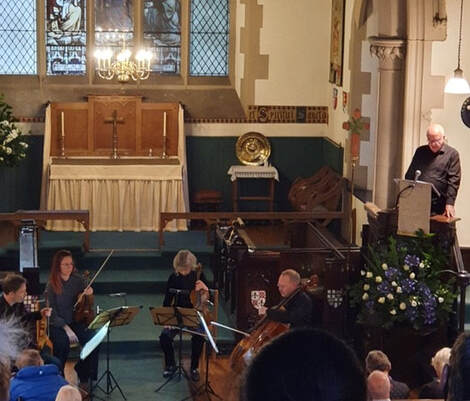
from Festival 2021
The Edinburgh Quartet
Haydn's Seven Last Words from the Cross
interspersed with poetry
Review from the Edinburgh Guide. ‘The Seven Last Words of Our Saviour on the Cross’ comprises seven sonatas between an introductory movement and the closing ‘Earthquake’ section. Each sonata was originally intended to accompany otherwise silent periods of reflection following each of the seven sermons in the church’s Good Friday liturgy. In turn, each of the sermons would have focused on one of the seven ‘last words’ that the Bible reports were uttered by Christ during the very last moments of his earthly life. We have heard the Edinburgh Quartet perform Haydn’s celebrated masterpiece at the Fringe before, and here again the recital was accomplished. Similarly, in place of the ‘sermons’, poetry was again read – but this year the selection made all the difference, with each piece having an overtly Passiontide theme. The result was transformative: a liturgical experience rather than pure performance, the poems and the sonatas complimenting each other beautifully, and more authentic to the context in which Haydn’s work would have been originally performed. Each poem concluded with the reader announcing the ‘Word’ that was the inspiration for the following sonata, and this signposting helped give structure to a recital that can otherwise seem to appear as a lengthy compendium of separate musical works. For some, the absence of audio speakers in the gallery meant that there was a little difficulty in hearing a couple of the items of spoken word. Nonetheless, the vibrancy and colour of the music was astounding.
The Edinburgh Quartet
Haydn's Seven Last Words from the Cross
interspersed with poetry
Review from the Edinburgh Guide. ‘The Seven Last Words of Our Saviour on the Cross’ comprises seven sonatas between an introductory movement and the closing ‘Earthquake’ section. Each sonata was originally intended to accompany otherwise silent periods of reflection following each of the seven sermons in the church’s Good Friday liturgy. In turn, each of the sermons would have focused on one of the seven ‘last words’ that the Bible reports were uttered by Christ during the very last moments of his earthly life. We have heard the Edinburgh Quartet perform Haydn’s celebrated masterpiece at the Fringe before, and here again the recital was accomplished. Similarly, in place of the ‘sermons’, poetry was again read – but this year the selection made all the difference, with each piece having an overtly Passiontide theme. The result was transformative: a liturgical experience rather than pure performance, the poems and the sonatas complimenting each other beautifully, and more authentic to the context in which Haydn’s work would have been originally performed. Each poem concluded with the reader announcing the ‘Word’ that was the inspiration for the following sonata, and this signposting helped give structure to a recital that can otherwise seem to appear as a lengthy compendium of separate musical works. For some, the absence of audio speakers in the gallery meant that there was a little difficulty in hearing a couple of the items of spoken word. Nonetheless, the vibrancy and colour of the music was astounding.
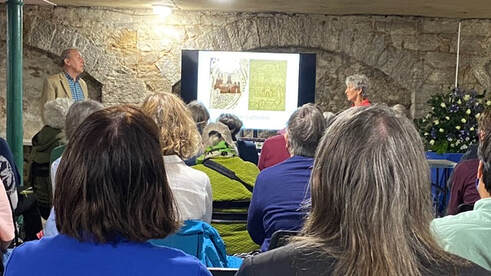
from Festival 2021
Zoe van Zwanenberg
The Art of Embroidery talk and exhibition
Review from the Edinburgh Guide Led by Tracy A Franklin, a team of Broderers with Durham Cathedral have been industriously working through Covid to produce a brand new vestment. The cope, a cloak-like garment traditionally worn for church services, has been patterned on scenes reflecting the life of St Cuthbert, whose shrine lies within the Cathedral. When finished, the cope will eventually be displayed within the Cathedral’s new ‘Open Treasure’ exhibition. Zoe van Zwanenberg, one of the team involved, gave a fascinating and highly sophisticated talk describing the process of making the item. Settled in the Undercroft of St Vincent’s Chapel, we were shown an array of slides taking us right through the process. From a sample of the sixteen sections needed, we first saw the images that inspired each panel. These then had to be translated into a design to make. A time for Q&A followed the talk. We learned that one of the simpler panels was estimated to have taken 275 hours to complete. For all the stitchers involved, although spread across the country, it was yet a coming together for a common commitment; for some, a journey of meditation and contemplation too. The stitchers kept in contact through social media, and were able to share updates on the progress for the panels they were making. This was a distinctly technical and unusual Fringe event – but it clearly attracted a niche group of people who might otherwise not have been reached.
Zoe van Zwanenberg
The Art of Embroidery talk and exhibition
Review from the Edinburgh Guide Led by Tracy A Franklin, a team of Broderers with Durham Cathedral have been industriously working through Covid to produce a brand new vestment. The cope, a cloak-like garment traditionally worn for church services, has been patterned on scenes reflecting the life of St Cuthbert, whose shrine lies within the Cathedral. When finished, the cope will eventually be displayed within the Cathedral’s new ‘Open Treasure’ exhibition. Zoe van Zwanenberg, one of the team involved, gave a fascinating and highly sophisticated talk describing the process of making the item. Settled in the Undercroft of St Vincent’s Chapel, we were shown an array of slides taking us right through the process. From a sample of the sixteen sections needed, we first saw the images that inspired each panel. These then had to be translated into a design to make. A time for Q&A followed the talk. We learned that one of the simpler panels was estimated to have taken 275 hours to complete. For all the stitchers involved, although spread across the country, it was yet a coming together for a common commitment; for some, a journey of meditation and contemplation too. The stitchers kept in contact through social media, and were able to share updates on the progress for the panels they were making. This was a distinctly technical and unusual Fringe event – but it clearly attracted a niche group of people who might otherwise not have been reached.
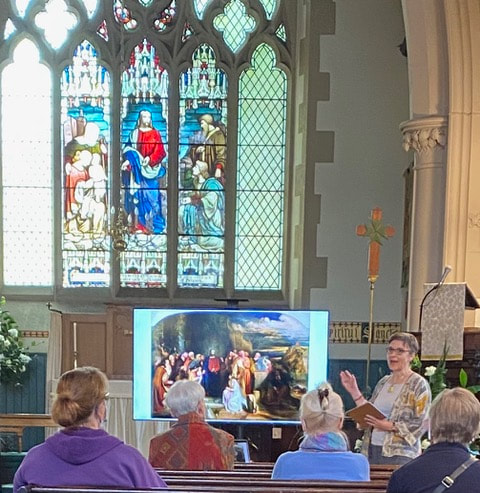
from Festival 2021
Scottish Religious Art in Paint and Glass
The story of Robert Scott Lauder’s “Christ Teacheth Humility”
With Dr Patricia Allerston, Deputy Director of European and Scottish Art & Dr Freya Spoor, Assistant Curator, 'Celebrating Scotland's Art', National Galleries of Scotland
Robert Scott Lauder (1803-69) was an Edinburgh artist and founding member of the Royal Scottish Academy whose painting Christ Teacheth Humility was one of the first purchases of the newly established National Gallery of Scotland. It provided the image that was used for the impressive East Window in St Vincent's Chapel. The painting is currently being restored, and this talk explored its history and importance.
Scottish Religious Art in Paint and Glass
The story of Robert Scott Lauder’s “Christ Teacheth Humility”
With Dr Patricia Allerston, Deputy Director of European and Scottish Art & Dr Freya Spoor, Assistant Curator, 'Celebrating Scotland's Art', National Galleries of Scotland
Robert Scott Lauder (1803-69) was an Edinburgh artist and founding member of the Royal Scottish Academy whose painting Christ Teacheth Humility was one of the first purchases of the newly established National Gallery of Scotland. It provided the image that was used for the impressive East Window in St Vincent's Chapel. The painting is currently being restored, and this talk explored its history and importance.

from Festival 2019
Erlend Tait: The Art of Stained Glass
Talk and Demonstration
For centuries, the art of stained glass has embellished and enriched places of worship and continues to do so. Erlend Tait is one of a very small number of stained glass artists based in Scotland. After art school, he served a 7 year traineeship at Christian Shaw Stained Glass, one of the UK’s leading ecclesiastical stained glass firms. He has completed more than 40 design commissions in both ecclesiastical and secular settings. This was a unique opportunity to discover more about this ancient art.
Erlend Tait: The Art of Stained Glass
Talk and Demonstration
For centuries, the art of stained glass has embellished and enriched places of worship and continues to do so. Erlend Tait is one of a very small number of stained glass artists based in Scotland. After art school, he served a 7 year traineeship at Christian Shaw Stained Glass, one of the UK’s leading ecclesiastical stained glass firms. He has completed more than 40 design commissions in both ecclesiastical and secular settings. This was a unique opportunity to discover more about this ancient art.

from Festival 2019
Rossini: Petite messe solennelle
The Reid Consort, directed by Cole Bendall
Gioachino Rossini's last work, the Petite messe solennelle (Little solemn mass), was composed in 1863. Rossini was living in Paris, having stopped writing operas over 30 years previously. He described the mass as "the last of my sins of old age”. It was originally scored for twelve singers, including four soloists, accompanied by two pianos and a harmonium. In this performance the accompaniment was four hands piano.
"Don’t miss the stunning sounds of one of Scotland’s premiere chamber choirs" Edinburgh Guide
Rossini: Petite messe solennelle
The Reid Consort, directed by Cole Bendall
Gioachino Rossini's last work, the Petite messe solennelle (Little solemn mass), was composed in 1863. Rossini was living in Paris, having stopped writing operas over 30 years previously. He described the mass as "the last of my sins of old age”. It was originally scored for twelve singers, including four soloists, accompanied by two pianos and a harmonium. In this performance the accompaniment was four hands piano.
"Don’t miss the stunning sounds of one of Scotland’s premiere chamber choirs" Edinburgh Guide

from Festival 2019
St MARK LIVE! A dramatic presentation of the Gospel According to Mark
As a spiritual discipline, Gerald Osborne spent three years memorising the Gospel of St Mark. With the guidance of scriptwriter Colin Heber-Percy, drawing on his knowledge of theatre, a setting was devised in which St Mark dictates his Gospel to a pagan Roman scribe. Working through the night to get this priceless text recorded, the scribe becomes more and more engaged, asking questions that an audience might wonder about. St Mark Live! has been performed at venues all over the UK, including Salisbury Cathedral and Bath Abbey. “Gerald Osborne's brilliant acting brought the life and suffering of Jesus ALIVE”; “So much drama, a stunning performance”; “a remarkable evening . . . a tour de force”.
St MARK LIVE! A dramatic presentation of the Gospel According to Mark
As a spiritual discipline, Gerald Osborne spent three years memorising the Gospel of St Mark. With the guidance of scriptwriter Colin Heber-Percy, drawing on his knowledge of theatre, a setting was devised in which St Mark dictates his Gospel to a pagan Roman scribe. Working through the night to get this priceless text recorded, the scribe becomes more and more engaged, asking questions that an audience might wonder about. St Mark Live! has been performed at venues all over the UK, including Salisbury Cathedral and Bath Abbey. “Gerald Osborne's brilliant acting brought the life and suffering of Jesus ALIVE”; “So much drama, a stunning performance”; “a remarkable evening . . . a tour de force”.

from Festival 2019
"The Poetry of God and War : from the Book of Exodus to the nuclear age"
a collaboration with Golden Hare Books
UK Independent Bookshop of the Year 2019
Among the many subjects that have inspired poets, the two most common are love and war. While the aspects of love that poets explore and celebrate have remained the same, across the centuries the poetry of war has undergone a change. A new focus on the destructive and dehumanizing impact of modern warfare has been added to the age-old themes of heroism, sacrifice, victory and loss. This presentation of poetry from ancient to recent times offered the audience a chance to hear and reflect on how religious poetry has reflected this change.
"The Poetry of God and War : from the Book of Exodus to the nuclear age"
a collaboration with Golden Hare Books
UK Independent Bookshop of the Year 2019
Among the many subjects that have inspired poets, the two most common are love and war. While the aspects of love that poets explore and celebrate have remained the same, across the centuries the poetry of war has undergone a change. A new focus on the destructive and dehumanizing impact of modern warfare has been added to the age-old themes of heroism, sacrifice, victory and loss. This presentation of poetry from ancient to recent times offered the audience a chance to hear and reflect on how religious poetry has reflected this change.
from Festival 2018
THE ART OF THE ICON
Exhibition by the Edinburgh School of Icon Painting
The Edinburgh School of Icon Painting, was founded in September 2013. Its mission is to make icon painting and art, in general, more accessible. This exhibition of 20 icons ran for a week and attracted a great deal of interest. It included two talk/demonstrations on the art of icon making by Basia Mindewizc, Director of the Edinburgh School.
THE ART OF THE ICON
Exhibition by the Edinburgh School of Icon Painting
The Edinburgh School of Icon Painting, was founded in September 2013. Its mission is to make icon painting and art, in general, more accessible. This exhibition of 20 icons ran for a week and attracted a great deal of interest. It included two talk/demonstrations on the art of icon making by Basia Mindewizc, Director of the Edinburgh School.
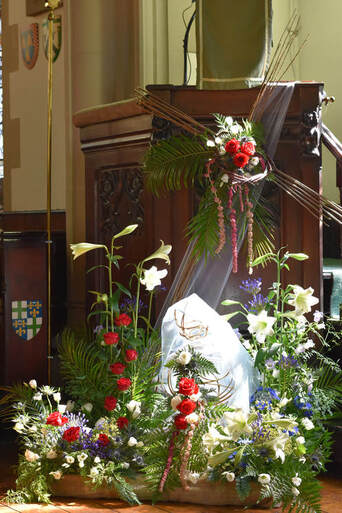
from Festival 2018
FLORAL ART FOR THE FEAST DAY OF ST MARY
A collaborative exhibition of flowers, poems and recorded music
The art of flower arranging in the service of Christian worship has a long history, but the skill and artistry involved is rarely sufficiently appreciated. This exhibition drew on the talents of flower guilds from six different Edinburgh churches.
Participating Flower Guilds
Church of the Good Shepherd, Murrayfield
Old St Paul's Episcopal Church, Jeffrey Street
St John's Episcopal Church, Princes Street
St Mary's Episcopal Cathedral
St Ninian's Episcopal Church, Comely Bank
St Vincent's Chapel, Stockbridge
FLORAL ART FOR THE FEAST DAY OF ST MARY
A collaborative exhibition of flowers, poems and recorded music
The art of flower arranging in the service of Christian worship has a long history, but the skill and artistry involved is rarely sufficiently appreciated. This exhibition drew on the talents of flower guilds from six different Edinburgh churches.
Participating Flower Guilds
Church of the Good Shepherd, Murrayfield
Old St Paul's Episcopal Church, Jeffrey Street
St John's Episcopal Church, Princes Street
St Mary's Episcopal Cathedral
St Ninian's Episcopal Church, Comely Bank
St Vincent's Chapel, Stockbridge
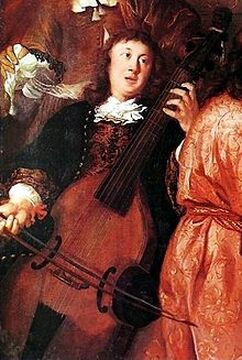
from Festival 2018
SCHÜTZ'S RESURRECTION STORY with music by Bach and Byrd
Coro Vincenzo & Squair Mile Consort of Viols
Les Shankland, Director of Music, St Vincent’s Chapel
Heinrich Schütz, perhaps the most highly regarded composer in 17th century Germany, wrote The Resurrection History on returning to Germany in 1623, following a period of study in Venice with Giovanni Gabrieli. This beautiful work takes biblical scenes from the period immediately following the Crucifixion, and sets them to music of intensely measured austerity and flowing polyphony. The biblical narrative is sung by a tenor soloist accompanied by a consort of viols, and the other characters in the story sing music in solo, or duet form supported by a group of continuo instruments.
SCHÜTZ'S RESURRECTION STORY with music by Bach and Byrd
Coro Vincenzo & Squair Mile Consort of Viols
Les Shankland, Director of Music, St Vincent’s Chapel
Heinrich Schütz, perhaps the most highly regarded composer in 17th century Germany, wrote The Resurrection History on returning to Germany in 1623, following a period of study in Venice with Giovanni Gabrieli. This beautiful work takes biblical scenes from the period immediately following the Crucifixion, and sets them to music of intensely measured austerity and flowing polyphony. The biblical narrative is sung by a tenor soloist accompanied by a consort of viols, and the other characters in the story sing music in solo, or duet form supported by a group of continuo instruments.